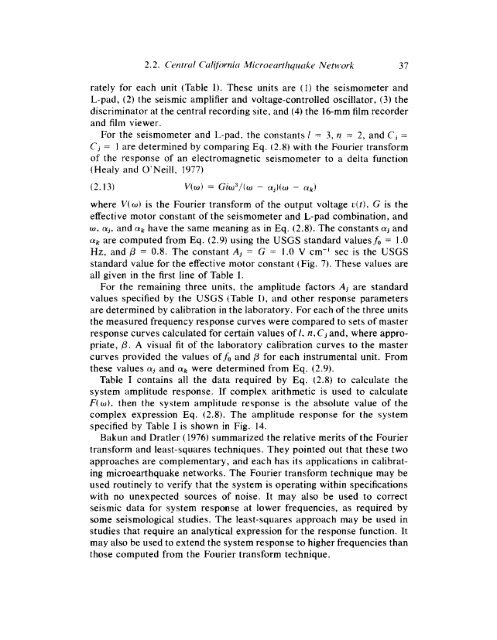principles and applications of microearthquake networks
principles and applications of microearthquake networks
principles and applications of microearthquake networks
You also want an ePaper? Increase the reach of your titles
YUMPU automatically turns print PDFs into web optimized ePapers that Google loves.
2.2. C'errtrcil C'alifornicr Microecit-thqmke Netirwk 37<br />
rately for each unit (Table I). These units are (1) the seismometer <strong>and</strong><br />
L-pad, (2) the seismic amplifier <strong>and</strong> voltage-controlled oscillator, (3) the<br />
discriminator at the central recording site, <strong>and</strong> (4) the 16-mm film recorder<br />
<strong>and</strong> film viewer.<br />
For the seismometer <strong>and</strong> L-pad, the constants I = 3 , = ~ 2, <strong>and</strong> Ci =<br />
Cj = 1 are determined by comparing Eq. (2.8) with the Fourier transform<br />
<strong>of</strong> the response <strong>of</strong> an electromagnetic seismometer to a delta function<br />
(Healy <strong>and</strong> O'Neill, 1977)<br />
(2.13) V(O) = G~w~/(w - aj)(w - C Y ~ )<br />
where V(w) is the Fourier transform <strong>of</strong> the output voltage u(t), G is the<br />
effective motor constant <strong>of</strong> the seismometer <strong>and</strong> L-pad combination, <strong>and</strong><br />
w, aj, <strong>and</strong> cxk have the same meaning as in Eq. (2.8). The constants cq <strong>and</strong><br />
ak are computed from Eq. (2.9) using the USGS st<strong>and</strong>ard values& = 1.0<br />
Hz, <strong>and</strong> /3 = 0.8. The constant A, = G = 1.0 V cm-' sec is the USGS<br />
st<strong>and</strong>ard value for the effective motor constant (Fig. 7). These values are<br />
all given in the first line <strong>of</strong> Table I.<br />
For the remaining three units, the amplitude factors Aj are st<strong>and</strong>ard<br />
values specified by the USGS (Table I), <strong>and</strong> other response parameters<br />
are determined by calibration in the laboratory. For each <strong>of</strong> the three units<br />
the measured frequency response curves were compared to sets <strong>of</strong> master<br />
response curves calculated for certain values <strong>of</strong> I, n, Cj <strong>and</strong>, where appropriate,<br />
@. A visual fit <strong>of</strong> the laboratory calibration curves to the master<br />
curves provided the values <strong>of</strong>fo <strong>and</strong> /3 for each instrumental unit. From<br />
these values aj <strong>and</strong> ak were determined from Eq. (2.9).<br />
Table I contains all the data required by Eq. (2.8) to calculate the<br />
system amplitude response. If complex arithmetic is used to calculate<br />
F(w), then the system amplitude response is the absolute value <strong>of</strong> the<br />
complex expression Eq. (2.8). The amplitude response for the system<br />
specified by Table I is shown in Fig. 14.<br />
Bakun <strong>and</strong> Dratler (1976) summarized the relative merits <strong>of</strong> the Fourier<br />
transform <strong>and</strong> least-squares techniques. They pointed out that these two<br />
approaches are complementary, <strong>and</strong> each has its <strong>applications</strong> in calibrating<br />
<strong>microearthquake</strong> <strong>networks</strong>. The Fourier transform technique may be<br />
used routinely to verify that the system is operating within specifications<br />
with no unexpected sources <strong>of</strong> noise. It may also be used to correct<br />
seismic data for system response at lower frequencies, as required by<br />
some seismological studies. The least-squares approach may be used in<br />
studies that require an analytical expression for the response function. It<br />
may also be used to extend the system response to higher frequencies than<br />
those computed from the Fourier transform technique.






